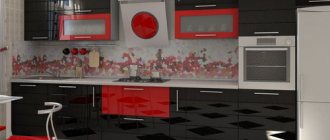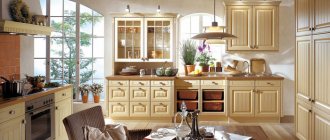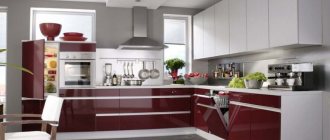Appliances are an integral part of the kitchen; without them, the cooking area will turn into an ordinary room. Therefore, when drawing up a design project, devices must be taken into account. In small kitchens they take up a significant part of the space.
Previously, they tried to display equipment, making it the highlight of the interior. Nowadays, harmonious designs are more popular, in which nothing stands out from the general style. Therefore, apartment owners are increasingly giving preference to built-in appliances. Which built-in appliances to choose for the kitchen and what to pay attention to – read on.
Features of choosing appliances for different kitchens
The kitchen appliances market is overflowing with devices that make the housewife’s work easier in the kitchen. To choose the optimal set, pay attention to the following parameters.
Kitchen size
In spacious rooms it is not difficult to place equipment of any purpose and size, which cannot be said about small kitchens. For small rooms, choose essential appliances. It is worth taking a closer look at models with reduced dimensions, especially for compact cooking areas.
Number of household members
Family size largely dictates the size and choice of appliances. If a hob with two burners is enough for two people, then for a large family you will need standard-sized appliances.
For a married couple, a dishwasher will not be necessary, and in an apartment where 4 or more people live, such a device will make the owner’s life much easier.
Needs of the housewife and household members
When choosing appliances that are not on the list of must-haves in the kitchen, you are guided by your own needs. If household members do not like coffee or drink it only in instant form, they do not need a coffee machine, but such a gadget will make coffee lovers happy. The same applies to the yogurt maker, food processor, grill.
Functionality of already purchased devices
If the oven has convection and grill functions, there is no need to overpay for a microwave oven with the same capabilities.
Furniture
Built-in appliances are hidden behind furniture facades. Therefore, the size of the niches in the headset must match the dimensions of the devices.
Budget
The cost depends on the manufacturer, design, control method and functionality. The more famous the manufacturer, the more innovative the device, and the more different functions it has, the higher the price.
Advice. If your budget allows you to buy equipment with a large number of additional functions from a little-known company, or devices with fewer additions, but from a well-established manufacturer, it is better to choose the second option.
Pros and cons of built-in kitchen appliances
After moving to a new apartment, a friend invited me to evaluate the renovation of the kitchen. A white set in a classic style, a table and chairs perfectly matched to it, there’s nothing to complain about. But... Wait, where is the refrigerator, oven, dishwasher, the convenience of which my friend buzzed all ears about? “So everything is built in,” the hostess smiled. Built-in appliances are in great demand today. Let's try to figure out what advantages it has and whether there are any disadvantages
tvoioboi.com
PROS
• Aesthetics
A kitchen with built-in appliances looks stylish and trendy. No unnecessary parts or wires. There was a time when owners sought to boast of having a variety of equipment. Electric kettles, microwave ovens, toasters, waffle irons - all this spoke of prosperity. But often household appliances did not harmonize with each other and stood out from the overall style of the kitchen. They began to hide them. And today it is the built-in appliances that speak of the status, excellent taste and progressiveness of the owners.
• Versatility
Whatever style you choose for your kitchen set, be it Provence, country or high-tech, the built-in appliances will not contrast with it, as they will be hidden behind the doors. It will not violate the asceticism of strict minimalism, nor will it spoil the decoration of luxurious baroque.
• Ergonomics
Types of built-in equipment
To decide on a set of built-in kitchen appliances, you should familiarize yourself with each of the presented options.
Fridge
It is difficult to imagine a modern kitchen without a refrigerator. It preserves the freshness of products and prepared meals.
The built-in refrigerator has a height of 1.5 to 2 m and is placed in a separate cabinet. There are partially and fully built-in refrigerators. In the first case, the device door is visible, and in the second case it is hidden behind the cabinet door.
The standard width of a refrigerator is 45-60 cm, depth is 50-55 cm. There are narrower and wider models. They are chosen depending on the size of the kitchen.
Wide refrigerators with two hinged doors that open in different directions are suitable for large rooms. Often, each door hides its own section, for example, a freezer or refrigerator.
There are models of refrigerators that are built into kitchen units. Their height does not exceed the height of the tabletop of the furniture set. Freezers with these parameters are also sold.
When choosing cooling equipment, pay attention to the defrosting system. The stores offer drip and No Frost models. It is recommended to choose the second option. Such refrigerators do not need to be defrosted, frost and liquid droplets do not form on the back wall, and they require repairs less often.
Useful features:
- freshness zone (shelf in the refrigerator with a temperature of 0°C);
- blast freezing mode;
- possibility of temperature adjustment;
- ice generator
Hob
The hob is another must-have element in the kitchen. Its thickness varies between 5-6 cm, and its width – 30-60 cm. The device is built into the kitchen countertop.
Without a hob, cooking is impossible. Therefore, it is worth deciding on the choice of this device first.
There are four types of hobs on the market. Each of them has its own advantages and disadvantages.
Gas
Gas cooks food faster than electric, since you don’t have to wait for the burner to heat up. Such products are cheaper than other options and are considered the most economical to operate. Their disadvantage is the presence of an open flame and the inability to set the exact temperature. Only a professional can connect a gas stove.
Electric
Such stoves operate from the mains. They are safer than gas ones, have the ability to regulate and maintain the temperature at the desired levels. They are more expensive to operate than gas options. It is possible to connect an electric hob without the help of a specialist.
Induction
A modern option that combines the advantages of the two previous types of hobs. Induction appliances are safe to use, allow you to set and maintain the desired temperature, and cook food quickly. This technique operates from the mains.
When in use, it is not the burner that heats up, but the cookware sitting on it. To use an induction hob, you will need special cookware. The cost and operation of such models is high.
Combined
One hob can accommodate different types of burners, for example, electric and gas. This allows you to use different power sources and cookware.
Note! An induction cooker increases the speed of cooking by 2 or more times. It will take 20-30 minutes to boil 5 liters of water on an electric stove, and 5-7 minutes on an induction stove.
The cost of hobs depends not only on their type, size, manufacturer, but also on the control method, as well as additional functions:
- Touch control. More often found in electrical engineering. Gives the device a modern and minimalistic look. Allows you to quickly turn on and regulate the heating of burners. But stoves with touch panels are less reliable than those with classic controls. If the sensor becomes unusable, replacing it will be expensive.
- Gas control. The function ensures the safety of using gas hobs. Thanks to a special sensor, the gas supply automatically stops if the flame goes out.
- Electric ignition . Available in modern gas appliances and runs on electricity. Allows you to light a flame on a burner without using another source of fire (for example, matches).
- Expansion zone. Allows you to change the heating zone depending on the diameter of the bottom of the pan, providing fast and economical heating. The function is available on electric and induction panels.
- Setting the exact temperature. All hobs have a temperature control function. Some modern electrical appliances have the ability to set the temperature with an accuracy of 1°C.
- Turbo burner . A burner on gas stoves with several rows of flames. Increases the speed of cooking.
- Lattices . Cast iron is considered the most durable.
- Beveled edge. Makes equipment maintenance easier.
Oven
The oven can be dependent on the hob (being one appliance with it) or independent (installed separately). The second option is more convenient, since in this case it can be installed at eye level.
Ovens are gas and electric. Gas appliances are inferior in terms of parameters: safety, temperature control and maintenance, functionality, heating uniformity.
The standard size of a niche for an oven is 60x60 cm. The volume of such ovens is 56 liters. For large families, equipment with a volume of 65 and 70 liters is produced. There are devices with reduced dimensions.
The choice of additional functions in devices is huge.
Tangential cooling
Present in most modern models. Thanks to a powerful fan that creates a barrier around the oven, the outer walls of the appliance do not heat up. This protects the furniture from deformation and reduces the risk of burns for household members.
Convection
The function is carried out thanks to the operation of a fan, which causes hot air to circulate inside the oven. This allows the dish to heat evenly on all sides, eliminating the risk of food burning on the bottom when the top is raw.
Timer
Allows you to set the cooking time. After the set time has elapsed, a signal sounds.
Auto power off
When using this function, the oven automatically turns off at the time specified by the owner.
Catalytic purification
It is provided by porous panels into which dirt is absorbed. During the cooking process, the latter are automatically decomposed into carbon, water and organic matter at a temperature of +140...+200°C.
The disadvantage of this system is its short service life (on average, panels are replaced every 5 years) and the need for manual cleaning of the door and bottom.
Cleaning by pyrolysis
When this mode is turned on, all contaminants are burned at a temperature of +500°C. All that remains is to wipe the oven with a damp cloth without special products. The cleaning cycle takes 90-150 minutes. The disadvantage is the unpleasant odor that accompanies cleaning.
Temperature dial sensor
Allows you to monitor temperature changes in the oven.
Microwave, grill, steamer
Performs the function of several devices.
Control
When choosing an oven, pay attention to the controls. It happens:
- mechanical - carried out by rotary handles (regular and recessed);
- electronic – touch or push-button;
- combined – combines several control options.
Dishwasher
A dishwasher makes a housewife's life much easier. Its width is 45 or 60 cm. The choice of size depends on the number of household members. The first option will accommodate up to 9 sets of dishes, the second – up to 12.
The dishwasher has a standard set of functions. Some manufacturers include additional features:
- Pre-rinse. Removes food residue from dishes. Can be used immediately before washing dishes or long before.
- Incomplete loading. The mode is used for washing a small amount of dishes. This reduces water consumption and reduces the operating time of the device.
- Programs. The manufacturer makes it possible to set the dishwashing mode depending on its type and level of contamination. For example, quick or intensive washing, cleaning fragile dishes, etc.
- Sterilization. Some devices have the ability to process hot steam. This function is convenient for people who have small children and housewives who do a lot of homework.
- Delay start timer. The function allows you to set the start time of the dishwasher in advance.
- Automatic locking. The mechanism automatically pulls and locks the door.
Hood
The hood cleans the air in the kitchen from grease, soot and unpleasant odors. It makes cleaning the room easier and makes staying in the kitchen more comfortable. This technique is not necessary, but its presence is desirable. Especially if the kitchen is combined with the living room.
The width of built-in hoods varies between 35-90 cm. The devices are built into wall cabinets above the hob.
Hoods are divided into two types:
- Branches. Connected to a ventilation system that connects them to the street. Hoods draw air in the kitchen and exhaust it outside.
- Cleansing. They are not connected to ventilation, but purify the air themselves by passing it through filters.
Hoods vary in power, noise level, type of filters and control method.
Other types of built-in equipment
There are other built-in appliances used in the kitchen. For example:
- coffee machine;
- microwave;
- washing machine;
- kettle;
- deep fryer;
- grill;
- food processor.
Advantages and disadvantages of built-in technology
Advantages:
- The most important and undeniable advantage of built-in appliances is its practicality and saving of kitchen space. The equipment is placed in those places that are convenient for the owner.
- With proper distribution and installation of equipment, energy consumption is reduced, built-in equipment does not operate so loudly, providing reliable sound insulation.
- Each piece of household appliance saves space, and its correct location allows you to functionally use each unit and feel comfortable in the kitchen.
- Installing built-in household appliances is easy. It is much more convenient to install a heavy hob into furniture than to install an ordinary gas or electric stove.
- Built-in household appliances are harmoniously combined with all elements of the kitchen.
Flaws:
- Quite a high price.
- The need to spend more time selecting the necessary equipment and discussing installation nuances with the specialist.
- Dependent built-in equipment, in case of redevelopment of the premises, cannot be moved from one place to another.
Selection of built-in equipment
When deciding which kitchen appliances are best to choose, you decide on a standard set that is really necessary.
The set of required devices includes:
- hob;
- fridge;
- oven.
In small kitchens it is often not possible to install a large number of gadgets. In this case, pay attention to multifunctional models. For example, they buy an oven with steamer, convection and microwave functions.
In order to fit a large amount of equipment in a small kitchen, they are looking at models with reduced dimensions. Most manufacturers offer such options.
Spacious rooms can accommodate any technical innovations. If the family is large, choose larger equipment.
Advice. Regardless of the size of the room, it is useful to equip it with a hood. The larger the room, the more powerful the device should be.
Advantages and disadvantages
Thanks to built-in appliances, kitchens look modern, and it’s not for nothing that its adherents are becoming more and more popular. However, it should be remembered that kitchen equipment of this type has its pros and cons.
pros
Built-in appliances are valued for their compactness. Compared to a regular one, it takes up about 20% less space, which is very important for small kitchens.
You can position it in a way that is convenient for better use of your workspace. It is not necessary to install the hob and oven together. The oven can be located in one place, and the stove in another.
The kitchen wins in terms of appearance. The equipment corresponds to the dimensions of the kitchen furniture, while free-standing elements of equipment may differ from the dimensions of the furniture set.
And finally, kitchens with built-in appliances are fashionable. In addition, decorating a kitchen in a certain style may require a certain type of kitchen unit, where there will be no room for a free-standing refrigerator or stove. Nowadays it is not customary to display equipment. It must function and be invisible.
Minuses
The main disadvantage of built-in technology is its impracticality in terms of replacement. Since it is built into the kitchen set, changing it is very difficult or only possible together with the pieces of furniture.
It will be very difficult to rearrange the kitchen. If with free-standing pieces of furniture and appliances this problem can be solved simply and quickly, then built-in appliances provide only one arrangement of furniture. If you’re tired of this arrangement, there’s nothing you can do, you’ll have to come to terms with it.
And another drawback is the price. You need to be prepared for the fact that you will have to pay a considerable amount of money, on average 30% more than for conventional free-standing models. At the same time, you often have to pay a lot for fashion brands.
To make the right choice, you need to clearly define the list of necessary devices, their models and the budget you are willing to spend.
Rating of brands of built-in kitchen appliances
When choosing household appliances, pay attention to models from manufacturers that have proven themselves in the market. The more famous the brand of the device, the greater the chance that it is of high quality and has a long service life.
There is a rating of kitchen appliance manufacturers. How is it created? Experts compare the performance of devices from different brands under extreme conditions, assemble and disassemble them. Based on the results, the company is given a score.
The list sorts the most famous brands according to their ratings:
- A (from 4.6 to 4.8 points): Bosh, Siemens, Miele, AEG, Toshiba, Sharp.
- A- (from 4.5 to 4.6 points): Nansa, Zanussi, Electrolux, Haier, Liebherr, Gorenje, Whirlpool.
- B+ (from 4.3 to 4.4 points): Ardo, LG, Candy, Hotpoint Ariston.
- B (from 4.1 to 4.2 points): Samsung, Gefest, Indesit.
- B- (from 4.5 to 4.6 points): Elenberg, Beko.
- C (from 4 points): Nord.
- C- (from 3.7 to 3.9 points): Vestel, Shivaki, Krona.
Cost of kits
The cost of equipment depends on its size, manufacturer and additional functions. The list shows the average cost of devices from well-established brands:
- dependent set of hob and oven - from 40 to 60 thousand rubles;
- hob – from 10 to 45 thousand rubles;
- oven - from 15 to 40 thousand rubles;
- microwave oven – 18-25 thousand rubles;
- refrigerator - 25-60 thousand rubles.
This is the average cost of class A and A- equipment. Manufacturers lower in the rating sell devices at a more budget price.
Principles of installation of built-in equipment
When installing built-in equipment, you must adhere to the following rules:
- Install equipment so that the overall appearance of the room is consistent in shape, color and texture.
- Methods of integrating equipment into a “table top” and into a “column” are widely used. In the first case, dishwashers, refrigerators, washing machines and hobs are installed, and the hood is left open. All small household appliances are placed in a drawer. In the second case, it is more practical and safer to install an oven in the “column”, a double boiler, and a microwave oven above it.
It is important that all necessary calculations and, directly, the installation of built-in household appliances, including the supply of electricity, water supply and sewerage, are carried out by qualified workers. Built-in household appliances have many advantages and have gained popularity not only in Russia, but also far beyond its borders.











